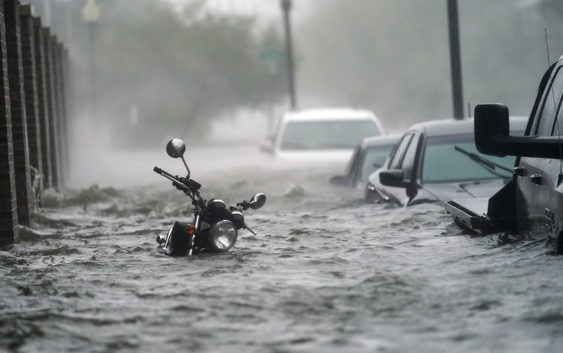- Fake job seekers are flooding the market, thanks to AI
- One set of evacuation orders lifted in Caldwell County after wildfire contained
- 'We gutted every building' | Chimney Rock rebuilding after Hurricane Helene
- 'We gutted every building' | Chimney Rock rebuilding after Hurricane Helene
- Debris from Hurricane Helene provides fuel, complicates containment for spring wildfires
Sally weakens but still dumping rain; Rivers threaten flooding

Coastal residents, meanwhile, looked to begin the recovery from a storm that turned streets into rivers, ripped roofs off buildings, knocked out power to hundreds of thousands and killed at least one person.
Sally’s path
Sally continues to weaken as it moves over the South after hitting the Gulf Coast as a Category 2 hurricane but is still a dangerous rainmaker as it moves into Georgia on a path to the Carolinas.
The tropical depression’s maximum sustained winds early Thursday have decreased to near 30 mph (45 kph) with additional weakening expected.
As of 5 a.m. EDT, Sally was centered about 50 miles (80 kilometers) southeast of Montgomery, Alabama, and is moving northeast near 12 mph (19 kph).
Authorities have warned that rain from the storm could swell eight waterways in Florida and Alabama to record levels. Some of the crests could submerge bridges and flood some homes, the National Weather Service warned. Florida Gov. Ron DeSantis warned residents and visitors of possible river flooding in the coming days.
Forecasters say tornadoes are possible Thursday across southern Georgia and northern Florida.
The National Hurricane Center said the system was moving through southeast Alabama, would cross over central Georgia and reach South Carolina on Thursday night. Flash flooding and river flooding was possible in each state. Forecasts say up to 1 foot (30 centimeters) of rain is possible in some spots.
Sally blew ashore near Gulf Shores, Alabama, on Wednesday morning as a major hurricane with 105 mph (165 kph) winds. It moved slowly, exacerbating the heavy rains’ effects. More than 2 feet (61 centimeters) fell near Naval Air Station Pensacola, and nearly 3 feet (1 meter) of water covered streets in downtown Pensacola, the National Weather Service reported.
Preparing your hurricane kit during COVID-19
Damage and death
At least one death was blamed on the hurricane. Orange Beach, Alabama. Mayor Tony Kennon told The Associated Press one person in the popular vacation spot died and another was missing as a result of the storm. He said he couldn’t immediately release details.
By Wednesday afternoon, authorities in Escambia County, which includes Pensacola, said at least 377 people had been rescued from flooded areas. More than 40 people trapped by high water were brought to safety within a single hour, including a family of four found in a tree, Sheriff David Morgan said.
Some Pensacola streets looked like rivers with whitecaps at times. The waters swamped parked cars before receding.
A replica of Christopher Columbus’ ship the Nina was missing from where it was docked at the Pensacola waterfront, police said. The ship was later seen run aground in downtown Pensacola, Pensacola News Journal reported.
As a hurricane, Sally tore loose a barge-mounted construction crane, which then smashed into the new Three Mile Bridge over Pensacola Bay, causing a section of the year-old span to collapse, authorities said. The storm also ripped away a large section of a fishing pier at Alabama’s Gulf State Park on the very day a ribbon-cutting had been scheduled following a $2.4 million renovation.
The storm was a nerve-racking experience for University of West Florida student Brooke Shelter. She was wide awake Wednesday morning as strong winds and rainfall battered her home, marking her first experience with a hurricane. “The damage around my home is pretty minor, for which I am thankful for,” Shelter said. “However, it is so sad seeing how flooded downtown is.”
In Orange Beach, Kennon said the damage was worse than that from Hurricane Ivan, which hit 16 years to the day earlier. In a Facebook briefing, Kennon said distribution points would be established Thursday for water, ice and tarps.
“It was an unbelievably freaky right turn of a storm that none of us ever expected,” Kennon said of Sally, which once appeared to have New Orleans in its sights.
Well over a half-million homes and businesses were without electricity in Alabama and Florida, according to poweroutages.us. Many faced extended time without power. “We don’t want to sugar coat this; we’re in it for the long haul,” one utility posted on social media.
Here’s what happens if we run out of names.
Other tropical systems
Sally is the earliest “S” storm in recorded history, and this year’s hurricane season is on pace to be the most active of all time.
The National Hurricane Center was tracking two other Atlantic storms. Hurricane Teddy that strengthened to a Category 2 hurricane early Thursday with maximum sustained winds of 105 mph.
The storm was located early Thursday about 625 miles (1,006 kilometers) east-northeast of The Lesser Antilles. Teddy was moving toward the northwest at about 12 mph (19 kph), the general motion it is expected to continue through the weekend.
Additional strengthening is forecast during the next couple of days; Teddy could become a major hurricane Thursday night or Friday, the hurricane center said.
Tropical Storm Vicky is expected to dissipate in the Atlantic in the coming days.
Like the wildfires raging on the West Coast, the onslaught of hurricanes has focused attention on climate change, which scientists say is causing slower, rainier, more powerful and more destructive storms.
Copyright © 2020 by The Associated Press. All Rights Reserved.